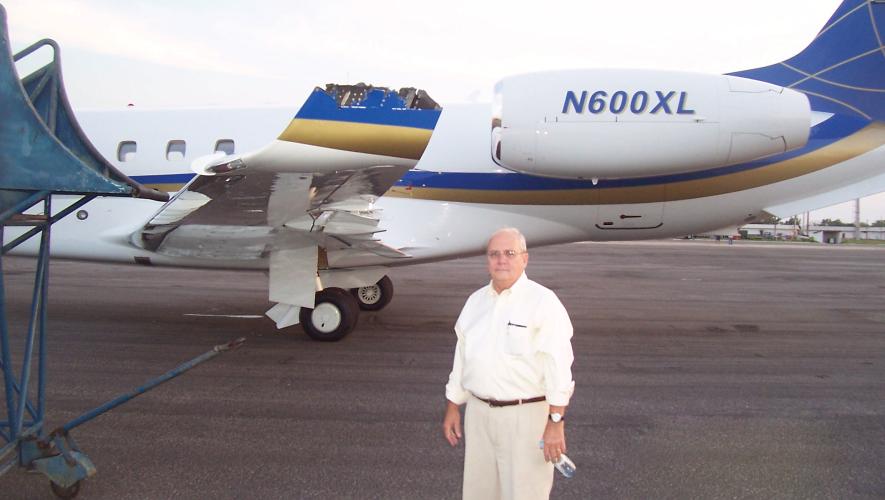With most flight departments and aircraft operators seeing vastly reduced flight hours as a result of the Covid-19 crisis, companies are looking for ways to keep their pilots’ skills sharp and ready for when demand increases. In a webinar presented by Wyvern on Wednesday, that problem was explored from the perspective of Part 91 and Part 135 operators.
Brad Self, chief pilot for VF Corp., noted that the company’s Denver-based flight department temporarily shut down on March 12. The flight stoppage was initially expected to be short-lived, but as the goalposts kept moving, Self began working on plans to keep flight crews current using professional flight management (PFM) tracking. The company has two Dassault Falcon 7Xs and a Falcon 900LX based at Denver Centennial Airport and a Falcon 50EX in Lugano, Switzerland. And to ensure night currency after two months of no flying, the department received permission for its crews to roll out one of the 7Xs one night to fly 18 traffic patterns.
Such a gap in flying also raises flags under the company’s flight risk assessment tool (FRAT), which is part of its safety management system. In response, Self suggested that pilots, especially those who relied on memorization in the past, return, at least temporarily, to following printed or digital checklists and to take their time with them as they shake off the rust upon returning to duty.
Self hopes to receive permission for his crews to begin making destination training flights in the aircraft and possibly incorporate the carrying of company employees who would otherwise be flying commercially. “We’re in the process now of getting approved where we can actually do flights, go up to altitude, cruise, go somewhere, set down, shut down the airplane, maybe pack a lunch, and then start the airplane back up and then return to base,” he said. “That takes care of two things we need to address—currency and recency of experience—and just being in the airplane and flying it.”
“We have to cycle the airplanes every three days irrespective of the current situation,” said Tom Benvenuto, senior v-p of flight operations for California-based aircraft charter/management provider Solairus Aviation, which has 190 aircraft under management and 70 on its charter certificate. “You get into some issues with warranty programs if you don’t exercise the airplanes.”
He explained that, under normal conditions, a large percentage of the company’s operations are international, with some of its 600 pilots racking up 50 to 60 flight hours a month, but that segment has completely come to a stop. “Fortunately, most of our clients have allowed us to take the airplane out and do takeoffs and landings and in some cases a few approaches,” said Benvenuto. “That’s been keeping our guys somewhat current, or at least fresh, so when we do spool up here in the near future, they’ll be ready to go.”
While Solairus typically conducts ground training in-house with its own instructors, with the shelter-in-place advice in many areas of the country and curtailing of non-essential travel, that has been done online of late. “So from the aspect of keeping current in their so-called 135 topics that they have to review annually, we haven’t missed a beat there,” Benvenuto said.
In terms of flying without passengers on board, Benvenuto said there could be a tendency for some pilots, to put it delicately, “do things that may not be what you would normally do with a passenger in the back.” He warned that it is important, particularly in this time of reduced flight opportunities and repetition, to maintain all safety standards and not take unnecessary risks.
Most of Solairus’s crewmembers take full recurrent training every six months, so the pilots that have come due in the last 90 days are only pushing their training by a few months so far, said Benvenuto.
With many operators taking advantage of the enforced downtime to conduct major maintenance and upgrades to their aircraft, that could also limit the availability of the aircraft for pilot currency use, said moderator Andrew Day, Wyvern’s senior director of quality and education. In those cases, he suggested some simulator stick time at the very least. Benvenuto advised that operators check their training contracts to see if such currency flights are part of their package. That, however, involves travel to the training centers. Solairus is also doing some of its check rides using simulators.
During this period, both VF Corp. and Solairus are combining their pilots' expertise and reduced schedules to help implement and conclude projects such as the rewriting of flight manuals and emergency response plans and, in the move toward paperless cockpits, developing procedures on how to easily locate documents.
“We don’t want to come out of this downtime still having projects that we had wished we had completed,” said Self. He added that as his company continues preparations for a return to flight operations, his department has received many questions on what is expected from the passengers during this period, and that advice is being compiled into a separate document for dissemination.
One thing Solairus suggests is having remote-based crewmembers regularly gather online in small groups, with each assigned to talk about various aircraft systems and procedures, to keep their minds aviation active. “That does two things,” said Benvenuto. ”It gets everybody back in the books, but it also provides the person who is providing the instruction some real insight into the systems. When you teach something, that’s when you really learn.”
One side effect of the pandemic is the end of the discussion on a major business aviation concern about finding qualified pilots, Benvenuto said. “This pilot shortage is over. There is no doubt in my mind that the airlines are going to start laying off guys left and right, thousands of pilots. That is going to be a benefit for us because we have taken a beating the last couple of years competing with the airlines.”







